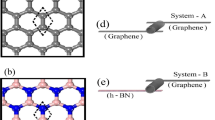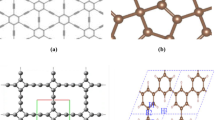Abstract
Due to unique features in surface activity, thermal stability, electrical and thermal conductivity, and compatibility with biomolecules such as DNA and proteins, carbon-based nanoparticles are raised potential as a candidate for various applications such as catalytic processes, drug delivery, light, and electrical engineering. Based on this premise, thermodynamic features of pure, graphene, and carbon nanotube (CNT)-based gold nanoparticles (AuNPs) are investigated using molecular dynamics approach. Melting, heat capacity, thermal conductivity, contact angle of molten AuNPs, and phase transition are calculated as indicators of thermodynamic properties of pure and carbon-based AuNPs. Simulation results indicate that the presence of a carbon platform and its contact surface area has a significant role in the thermodynamic properties of AuNPs and leads the phononic heat capacity and thermal conductivity to decrease for AuNPs. The platform also causes the melting point temperature of AuNPs to increase. The melting of gold on the carbon base is of the first-order type. In addition, contact angle for molten AuNPs on the Graphene is significantly higher than the one on the CNT due to more contact area on the Graphene substrate.
Graphical abstract

.











Similar content being viewed by others
References
Fedlheim DL, Foss CA (2001) Metal nanoparticles: synthesis, characterization, and applications. CRC press
Goncalves G, Marques PA, Granadeiro CM, Nogueira HI, Singh M, Gracio J (2009) Surface modification of graphene nanosheets with gold nanoparticles: the role of oxygen moieties at graphene surface on gold nucleation and growth. Chem Mater 21:4796–4802
Bhattacharya P, Lin S, Turner JP, Ke PC (2010) Physical adsorption of charged plastic nanoparticles affects algal photosynthesis. J Phys Chem C 114:16556–16561
Yang S, Pelton R, Raegen A, Montgomery M, Dalnoki-Veress K (2011) Nanoparticle flotation collectors: mechanisms behind a new technology. Langmuir 27:10438–10446
Hvolbæk B, Janssens TV, Clausen BS, Falsig H, Christensen CH, Nørskov JK (2007) Catalytic activity of au nanoparticles. Nano Today 2:14–18
Sun L, Yang X, Wu B, Tang L (2011) Molecular simulation of interaction between passivated gold nanoparticles in supercritical CO2. J Chem Phys 135:204703
Dou S, Li X, Tao L, Huo J, Wang S (2016) Cobalt nanoparticle-embedded carbon nanotube/porous carbon hybrid derived from MOF-encapsulated co 3 O 4 for oxygen electrocatalysis. Chem Commun 52:9727–9730
Sanchez A, Abbet S, Heiz U, Schneider W-D, Häkkinen H, Barnett R, Landman U (1999) When gold is not noble: nanoscale gold catalysts. J Phys Chem A 103:9573–9578
Krauss TD, Eisenberg R, Holland P, Qiu F, Han Z (2019) Methods for producing hydrogen using nanoparticle-catalyst mixtures. Google Patents
Tafrishi H, Sadeghzadeh S, Molaei F, Siavoshi H (2020) Investigating the effects of adding hybrid nanoparticles, graphene and boron nitride nanosheets, to octadecane on its thermal properties. RSC Adv 10:14785–14793
Elsayed I, Mashaly M, Eltaweel F, Jackson MA (2018) Dehydration of glucose to 5-hydroxymethylfurfural by a core-shell Fe3O4@ SiO2-SO3H magnetic nanoparticle catalyst. Fuel 221:407–416
Schlexer P, Widmann D, Behm RJR, Pacchioni G (2018) CO oxidation on a Au/TiO2 nanoparticle catalyst via the au-assisted Mars–van Krevelen Mechanism. ACS Catal 8:6513–6525
Callejas-Tovar R, Liao W, Martinez de la Hoz JM, Balbuena PB (2011) Molecular dynamics simulations of surface oxidation on Pt (111) and Pt/PtCo/Pt3Co (111). J Phys Chem C 115:4104–4113
Puértolas B, Mayoral Á, Arenal R, Solsona B, Moragues A, Murcia-Mascaros S, Amorós P, Hungría AB, Taylor SH, García T (2015) High-temperature stable gold nanoparticle catalysts for application under severe conditions: the role of TiO2 nanodomains in structure and activity. ACS Catal 5:1078–1086
Shang Z, Li S, Li L, Liu G, Liang X (2017) Highly active and stable alumina supported nickel nanoparticle catalysts for dry reforming of methane. Appl Catal B Environ 201:302–309
Arrigo R, Schuster ME, Xie Z, Yi Y, Wowsnick G, Sun LL, Hermann KE, Friedrich M, Kast P, Hävecker M (2015) Nature of the N–Pd interaction in nitrogen-doped carbon nanotube catalysts. ACS Catal 5:2740–2753
Onn TM, Zhang S, Arroyo-Ramirez L, Chung Y-C, Graham GW, Pan X, Gorte RJ (2015) Improved thermal stability and methane-oxidation activity of Pd/Al2O3 catalysts by atomic layer deposition of ZrO2. ACS Catal 5:5696–5701
Sarangi S, Satyam P, Nayak S, Mahanti S (2017) Molecular dynamics simulation studies of gold nano-cluster on silicon (001) surface. Indian J Phys 91:853–859
Fernández Navarro CJ, Mejía Rosales S (2013) Molecular dynamics of free and graphite-supported Pt-Pd nanoparticles. Adv Nanoparticles 2:323–328
Huang X, El-Sayed MA (2010) Gold nanoparticles: optical properties and implementations in cancer diagnosis and photothermal therapy. J Adv Res 1:13–28
Ganz E, Ganz AB, Yang L-M, Dornfeld M (2017) The initial stages of melting of graphene between 4000 K and 6000 K. Phys Chem Chem Phys 19:3756–3762
Mittal G, Dhand V, Rhee KY, Park S-J, Lee WR (2015) A review on carbon nanotubes and graphene as fillers in reinforced polymer nanocomposites. J Ind Eng Chem 21:11–25
Mabudi A, Noaparast M, Gharabaghi M, Vasquez V (2019) A molecular dynamics study on the wettability of graphene-based silicon dioxide (glass) surface. Colloids Surf A Physicochem Eng Asp 569:43–51
Filleter T, Bernal R, Li S, Espinosa HD (2011) Ultrahigh strength and stiffness in cross-linked hierarchical carbon nanotube bundles. Adv Mater 23:2855–2860
Font F, Bresme F (2018) Transient melting at the nanoscale: a continuum heat transfer and nonequilibrium molecular dynamics approach. J Phys Chem C 122:17481–17489
Vo TQ, Kim BH (2017) Molecular dynamics study of thermodynamic properties of nanoclusters for additive manufacturing. Int J Precis Eng Manuf Green Technol 4:301–306
Martínez L, Andrade R, Birgin EG, Martínez JM (2009) PACKMOL: a package for building initial configurations for molecular dynamics simulations. J Comput Chem 30:2157–2164
Pedireddy S, Lee HK, Tjiu WW, Phang IY, Tan HR, Chua SQ, Troadec C, Ling XY (2014) One-step synthesis of zero-dimensional hollow nanoporous gold nanoparticles with enhanced methanol electrooxidation performance. Nat Commun 5:4947
Zhang S (2011) Molecular dynamics simulation of gold nanopariticles and surface stress effect. Lehigh University
Plimpton S (1995) Fast parallel algorithms for short-range molecular dynamics. J Comput Phys 117:1–19
Humphrey W, Dalke A, Schulten K (1996) VMD: visual molecular dynamics. J Mol Graph 14:33–38
Daw MS, Foiles SM, Baskes MI (1993) The embedded-atom method: a review of theory and applications. Mater Sci Rep 9:251–310
Dauber-Osguthorpe P, Roberts VA, Osguthorpe DJ, Wolff J, Genest M, Hagler AT (1988) Structure and energetics of ligand binding to proteins: Escherichia coli dihydrofolate reductase-trimethoprim, a drug-receptor system. Proteins Struct Funct Bioinf 4:31–47
Yuan Q, Zhu X, Lin K, Zhao Y-P (2015) Molecular dynamics simulations of the enhanced recovery of confined methane with carbon dioxide. Phys Chem Chem Phys 17:31887–31893
Lennard-Jones JE (1931) Cohesion. Proc Phys Soc 43:461
Hoover WG (1985) Canonical dynamics: equilibrium phase-space distributions. Phys Rev A 31:1695
Holman JP (1986) Heat transfer. McGraw-hill, New York
Rastogi A, Rajpoot P, Rastogi R, Verma UP (2019) Ab-initio study of electronic, optical, thermal, and transport properties of Cr4AlB6. Int J Quantum Chem 119:e25897
Jain A, McGaughey AJ (2016) Thermal transport by phonons and electrons in aluminum, silver, and gold from first principles. Phys Rev B 93:081206
Ahadi Z, Shadman Lakmehsari M, Kumar Singh S, Davoodi J (2017) Stability and thermal behavior of molybdenum disulfide nanotubes: nonequilibrium molecular dynamics simulation using REBO potential. J Appl Phys 122:224303
Mohebbi A (2012) Prediction of specific heat and thermal conductivity of nanofluids by a combined equilibrium and non-equilibrium molecular dynamics simulation. J Mol Liq 175:51–58
Chen G, Hui P (1999) Thermal conductivities of evaporated gold films on silicon and glass. Appl Phys Lett 74:2942–2944
Dunne TG (1987) Physical chemistry, (Levine, Ira N.). ACS Publications
Pathria R, Beale PD (2011) Statistical mechanics. Elsevier, New York
Shrivastava A (2018) Introduction to plastics engineering. William Andrew
Stauffer E, Dolan JA, Newman R (2007) Fire debris analysis. Academic Press
Soma T, Kagaya HM, Nishigaki M (1983) Mean-square displacement and Lindeman's criterion for melting of alkali metals. Phys Status Solidi B 115:273–276
Fegley Jr B (2012) Practical chemical thermodynamics for geoscientists. Academic Press
Atkins PW, De Paula J, Keeler J (2018) Atkins’ physical chemistry. Oxford University Press
Hubbe MA, Koukoulas AA (2016) Wet-laid nonwovens manufacture–chemical approaches using synthetic and cellulosic fibers. BioResources 11:5500–5552
Mabudi A, Noaparast M, Gharabaghi M, Vasquez V (2019) Polystyrene nanoparticles as a flotation collector: a molecular dynamics study. J Mol Liq 275:554–566
Davoodi J, Safaralizade M, Yarifard M (2016) Molecular dynamics simulation of a gold nanodroplet in contact with graphene. Mater Lett 178:205–207
Funding
MD simulations and post-simulation analysis were performed using computing clusters at the Tarbiat Modares University, Tehran, Iran.
Author information
Authors and Affiliations
Corresponding author
Additional information
Publisher’s note
Springer Nature remains neutral with regard to jurisdictional claims in published maps and institutional affiliations.
Electronic supplementary material
ESM 1
(DOCX 1684 kb)
Rights and permissions
About this article
Cite this article
Gowdini, E., Ahmad, A.A., Mabudi, A. et al. A molecular dynamics study on the thermal properties of carbon-based gold nanoparticles. J Mol Model 26, 307 (2020). https://doi.org/10.1007/s00894-020-04559-2
Received:
Accepted:
Published:
DOI: https://doi.org/10.1007/s00894-020-04559-2




